Table of contents
What is eCommerce customer journey?
Ecommerce customer journey describes the entire experience of a customer with an online business, from the moment they first become aware of its products to the moment they complete a purchase and reach out for support.
Stages of eCommerce customer journey
In order to map an eCommerce customer journey, first, we need to understand each stage of the journey.
1. Awareness
This is the first stage of an eCommerce customer journey. During this stage, a problem occurs, causing the customer to go online and do research about their issue.
The customer at this stage may discover brands passively. It can be an advertisement they see, a social media or blog post, or actively through organic search.
A brand needs to extend its site visibility to customers to raise enough awareness and interest, urging them to find out more. As a business, you may learn how the customer arrived on your site and their behaviors – whether they just browse or look at a particular landing page. This can give you an idea about their interest.
2. Consideration
The customer may find something that interests them from your website. They are considering purchasing a specific item that can solve their problem, but also weighing different options.
For instance, a person is looking to purchase a mountain bike, and you are offering this product. The customer would look between your bike and a few others from your competitors. Factors such as features, price, reviews, return & refund policy, or promotion for the bike, may impact their decision.
You can influence a customer’s consideration by explaining your product’s advantages to make it appear as a potential solution.
3. Decision
At this stage, the customer is narrowing down their options for purchase. And a potential customer may turn into an actual one at this point, as long as you can convince your product is what they need.
It’s important to align other aspects of your business to make the purchase. For example, in-time customer support if they have any questions or an optimized checkout process with just 1 or 2 steps. Or if they have added the item in their cart but have yet to pay, you can provide a sense of urgency with a limited-time offer.
4. Retention
Getting a customer to purchase is nice, but seeing them return for more is much better for your business. It isn’t only cheaper to retain customers but also brings more revenue in return. According to Harvard Business Review, the cost for acquiring new customers is 5 to 25 times that of retaining an existing customer. And only a 5% increase in customer retention can increase company revenue by 25-95%.
However, this isn’t a stage that every business can achieve. A business may have provided excellent customer service once or twice post-purchase, but the real challenge is for them to keep up their standard support for the n-th time. And even just one negative experience is enough to turn your customer away.
5. Advocacy
Customers at this stage are your brand ambassadors. They actively interact with your brand through channels – on your site or social media. Better than that, they would share about your brand with family and friends. With their recommendation, these people may turn into your potential customers.
Besides, they also help boost your reputation by leaving positive reviews on social media or other review platforms. About 95% of customers read online reviews before making a purchase. And 94% of consumers saying positive reviews make them more likely to buy from a business. So having positive reviews from loyal customers is extremely important for your business.
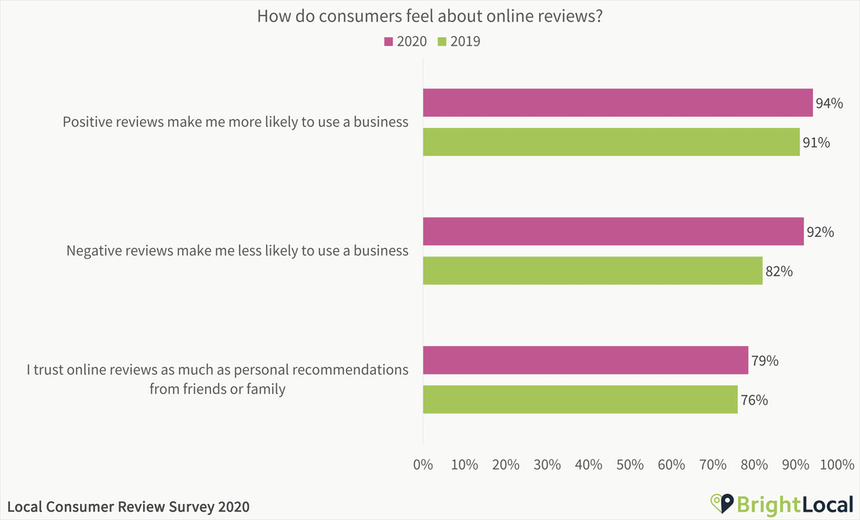
Steps to create a customer journey map
“An eCommerce customer journey map is a visual representation of all the touchpoints on a customer journey.” (Hubspot).
By creating an eCommerce customer journey map, you can further understand your customers and plan how to make the shopping experience enjoyable at every touchpoint.
1. Set your goals
Before starting working on mapping out the journey map, it’s crucial to identify what you want to achieve from this process. Doing so would make it easier to choose the most efficient ways to hit your targets.
It’s best if you have answers to these questions beforehand:
- Why are you making this map?
- Whose perspective will it be from?
- What experiences will you be factoring in?
2. Define customer personas
To build an effective map, you need to create customer personas. A customer persona is a semi-fictional character that represents a specific customer segment for your brand. Characteristics to be considered when creating personas include background, demographics, lifestyle, personality, information sources, and shopping preferences. It’s recommended that the personas are built based on real data.
There are many ways to gather customer data. You can use data tools like Google Analytics or collect direct feedback from buyers with surveys and questionnaires.
Then you need to combine their traits into numerous specific personas with memorable characteristics, even a name. The closer the personas are to the customer segment they represent, the higher chance you can improve the shopping experience for them in real life.

There are tools available to help you with quickly sketching a customer persona like Xtensio, Hubspot, etc.
3. Map out the customer journey stages and identify touchpoints
It’s time to create the stages in your framework for your customer journey map. Depending on your industry, the stages may vary, but a typical one has 5 stages as we mentioned above.
After you have the stages, identify all the touchpoints and include them in your framework. Touchpoint is an interaction a customer can have with the brand throughout their journey.
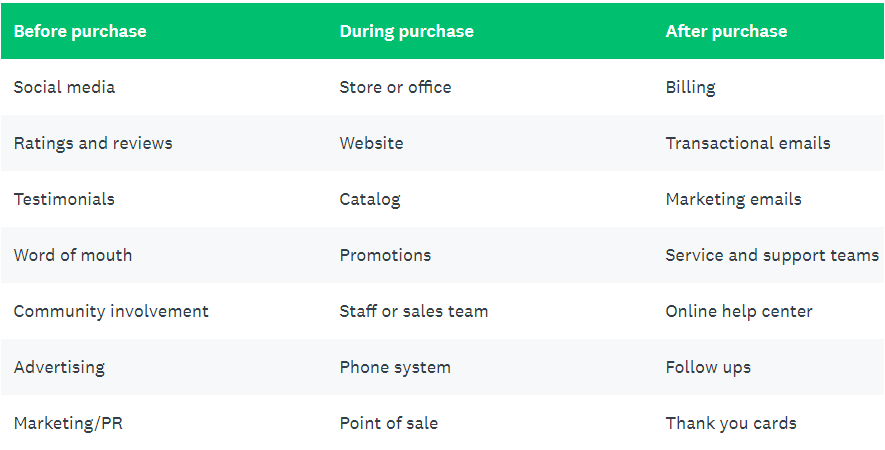
In this step, you can put yourself in the customer’s shoes to understand their journey. Try asking yourself:
“Where do I go (and how do I get there) when…”
…I have a problem (that your product/company solves)?
…I find the product or business that may solve my problem?
…I’m making my purchase decision?
…I reach out to the business for support after the purchase?
…I make my next purchase for similar products?
Another technique is to use data tools like Google Analytics to gain insight into the typical customer journey with the Behavior Flow report. The reports show exactly where the majority of users stop and leave, and the common flow of customers with touchpoints.
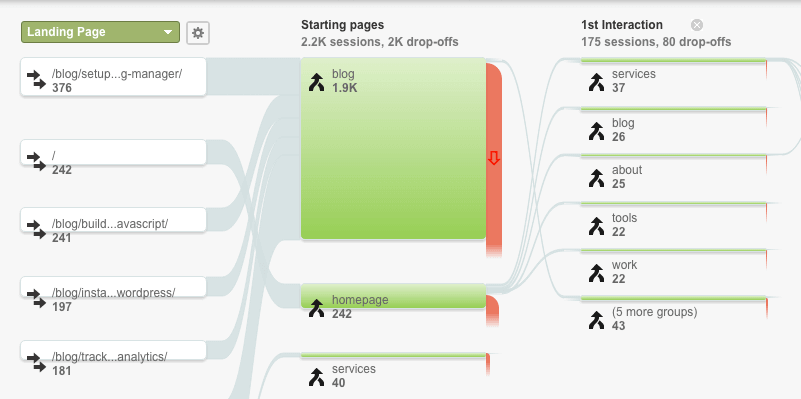
4. Bring your data together to find pain points
After you’ve created the framework for the journey, it’s time to combine the data from customer personas. The main goal of this step is to identify pain points and see the gap(s) in your customer experience.
Here are useful collections you can ask to understand your customers and figure out the pain points that are preventing them from making purchases:
- What is my customer thinking and feeling at each stage/ touchpoint?
- What questions are they asking, and what actions are they taking?
- What are their needs, expectations, and concerns for each of those points?
- How are their behaviors affected by personal emotions and goals?
- How is my business fulfilling the customer’s goals?
- How does their experience change as they move through the stages?
- What are the opportunities for generating more trust and building a stronger relationship with customers?
Once you’re done identifying the pain points, put them on the journey map for the next step.
5. Analyze and fix the gap(s) in your customer experience
Now that you have an eCommerce customer journey map with all the touchpoints and pain points, it’s time to work on analyzing the gap(s).
For example, if you see that customers leave their cart because of the complicated checkout process (too many steps or they have to register), a simplified one-page checkout may be the solution.
To achieve the best result, it’s recommended that you carry out A/B testing. If you want to urge new registered customers to come back to your site, you can try sending a normal welcome email and another one with a discount code and observe which’s more attractive for them. Or when your email’s open rate is under average, try to personalize it by adding the recipient’s name (this is one of the most impactful words to add to your subject line). Adding recipients’ names can increase your open rate by 14%!
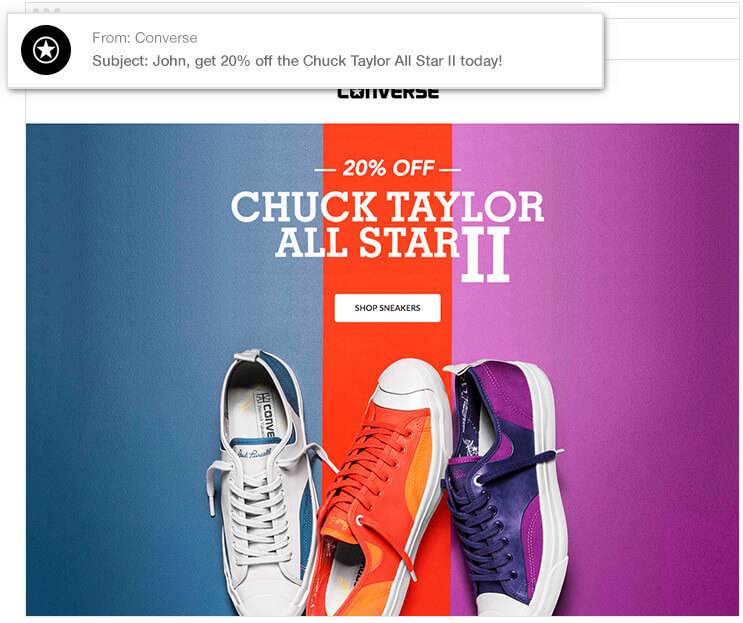
Or if you realize that your site hasn’t been optimized for mobile, which annoys your potential customers, a mobile-friendly website may be the answer. There are various scenarios of changes that can improve your conversion rate, as long as you know the gap(s) and understand how to close or minimize them.
Your eCommerce customer journey map can take a table form, or you can make it in a more creative way using available tools. Below you can find 2 journey maps – one in a table form, and the other has a few tweaks with drawings and colors.
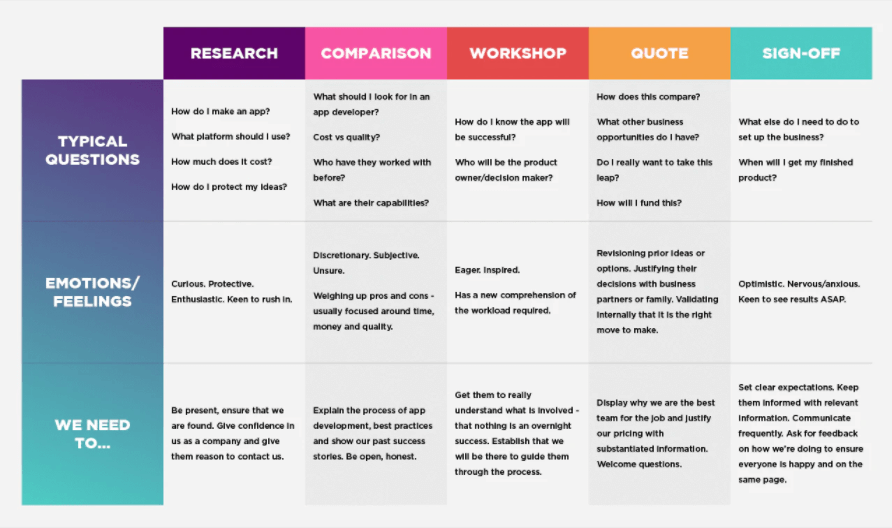
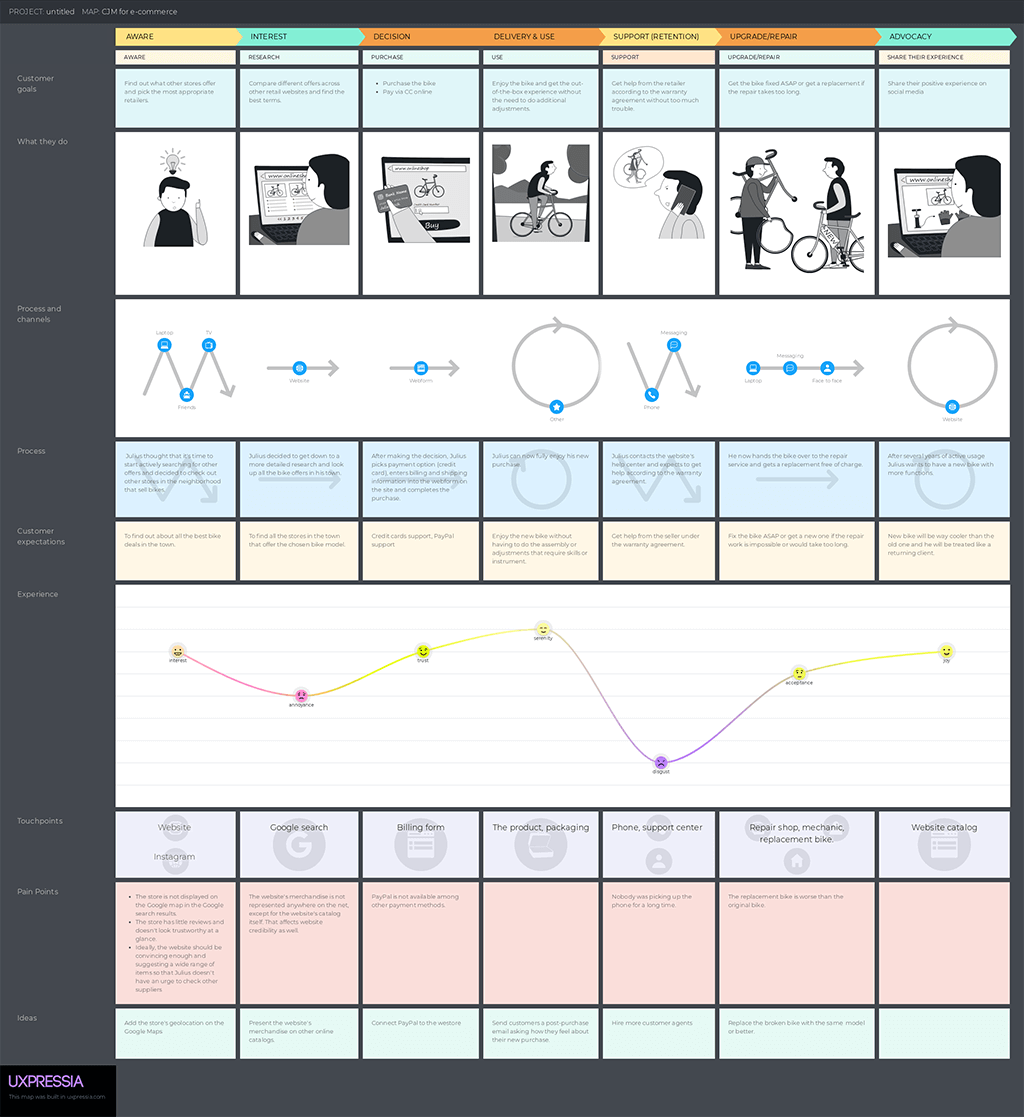
Tools like UXPRESSIA, Smaply, Lucidchart, Venngage, … are useful in visualizing your journey map with details.
So what’s next?
Creating a customer journey map is an essential process for any business, and eCommerce is no exception.
After identifying the gap(s), you may have plenty on hand to fix. Gaps may be discovered in different business aspects – sales, marketing, or customer support. So our advice is to check and prioritize tasks. The adjustments may not work right on the first try, but it’s ok. You can make tweaks until getting the desired results that will boost your bottom line.
Customer behavior changes constantly, which means you don’t settle with one journey map and hope it’d work forever. The best practice is to work on the mapping every few months to make sure you know what’s going on and are ready to provide customers with a smooth shopping experience.





